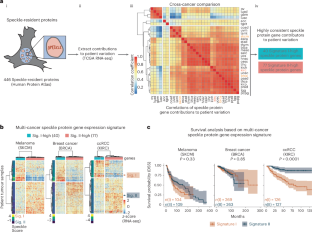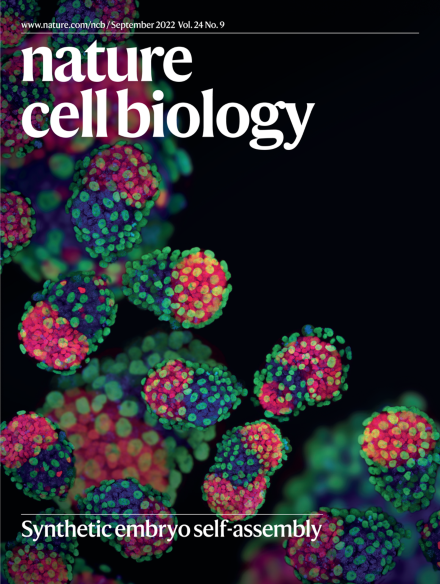核斑点调节癌症的功能程序
IF 17.3
1区 生物学
Q1 CELL BIOLOGY
引用次数: 0
摘要
核斑是动态的核体,其特征是参与RNA生产的高浓度因子。尽管斑点的内容提示其在基因调控中具有多方面的作用,但其生物学功能尚不清楚。在这里,我们研究人类癌症的斑点变异,发现两个主要特征。一个斑点特征与健康的邻近组织相似,而另一个则不同,被认为是异常的癌症斑点状态。异常斑点表明细胞核内位置改变,TREX RNA输出复合物水平升高,与透明细胞肾细胞癌(ccRCC)患者预后较差相关,透明细胞肾细胞癌是一种以HIF-2α转录因子过度激活为特征的癌症。我们证明HIF-2α促进某些靶基因与斑点的物理关联,这取决于HIF-2α蛋白斑点靶向基序,在本研究中定义。我们在许多转录因子中发现了同源斑点靶向基序,表明dna斑点靶向可能是一种普遍的基因调控机制。综合功能、基因组和成像研究,我们发现HIF-2α基因调控程序受到斑点状态和HIF-2α驱动的斑点靶向的影响。这些发现表明,在ccRCC中,核斑点的一个关键生物学功能是调节选定的hif -2α调控靶基因的表达,进而影响患者的预后。除ccRCC外,肿瘤斑点状态与斑点相关基因邻域的功能通路改变和表达广泛相关,揭示了人类癌症中核斑点与基因表达失调之间的普遍联系。本文章由计算机程序翻译,如有差异,请以英文原文为准。


Nuclear speckles regulate functional programs in cancer
Nuclear speckles are dynamic nuclear bodies characterized by high concentrations of factors involved in RNA production. Although the contents of speckles suggest multifaceted roles in gene regulation, their biological functions are unclear. Here we investigate speckle variation in human cancer, finding two main signatures. One speckle signature was similar to healthy adjacent tissues, whereas the other was dissimilar, and considered an aberrant cancer speckle state. Aberrant speckles show altered positioning within the nucleus, higher levels of the TREX RNA export complex and correlate with poorer patient outcomes in clear cell renal cell carcinoma (ccRCC), a cancer typified by hyperactivation of the HIF-2α transcription factor. We demonstrate that HIF-2α promotes physical association of certain target genes with speckles depending on HIF-2α protein speckle-targeting motifs, defined in this study. We identify homologous speckle-targeting motifs within many transcription factors, suggesting that DNA-speckle targeting may be a general gene regulatory mechanism. Integrating functional, genomic and imaging studies, we show that HIF-2α gene regulatory programs are impacted by speckle state and by abrogation of HIF-2α-driven speckle targeting. These findings suggest that, in ccRCC, a key biological function of nuclear speckles is to modulate expression of select HIF-2α-regulated target genes that, in turn, influence patient outcomes. Beyond ccRCC, tumour speckle states broadly correlate with altered functional pathways and expression of speckle-associated gene neighbourhoods, exposing a general link between nuclear speckles and gene expression dysregulation in human cancer. This study reports that nuclear speckle constituents have two expression states in cancer correlating with patient survival and HIF-2α functional programs. HIF-2α mediates nuclear speckle association of key genes activated in renal cancer.
求助全文
通过发布文献求助,成功后即可免费获取论文全文。
去求助
来源期刊

Nature Cell Biology
生物-细胞生物学
CiteScore
28.40
自引率
0.90%
发文量
219
审稿时长
3 months
期刊介绍:
Nature Cell Biology, a prestigious journal, upholds a commitment to publishing papers of the highest quality across all areas of cell biology, with a particular focus on elucidating mechanisms underlying fundamental cell biological processes. The journal's broad scope encompasses various areas of interest, including but not limited to:
-Autophagy
-Cancer biology
-Cell adhesion and migration
-Cell cycle and growth
-Cell death
-Chromatin and epigenetics
-Cytoskeletal dynamics
-Developmental biology
-DNA replication and repair
-Mechanisms of human disease
-Mechanobiology
-Membrane traffic and dynamics
-Metabolism
-Nuclear organization and dynamics
-Organelle biology
-Proteolysis and quality control
-RNA biology
-Signal transduction
-Stem cell biology
 求助内容:
求助内容: 应助结果提醒方式:
应助结果提醒方式:


